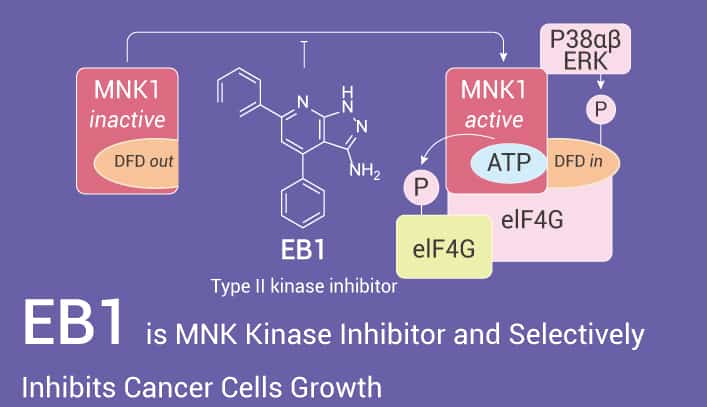MNKs (Mitogen-activated protein kinase interacting kinases) belong to the family of Ser/Thr kinases, and are classified as members of Ca2+/calmodulin-dependent kinases. MNKs have two different isoforms (MNK1 and MNK2) and play critical roles in the development of human malignancies. MNK1 and MNK2 execute a unique function in regulating eIF4E through phosphorylation at the conserved residue Ser 209. Importantly, eIF4E is a key component of the translational machinery and an important modulator of cell growth and proliferation.
MNK/eIF4E axis is involved in the expression of the pro-angiogenic, antiapoptotic, cell cycle, and motility proteins, such as MCL1, VEGF, MMP3, SNAIL, SMAD2, β-catenin or cyclin D1, and is essential during Ras and c Myc-induced transformation. This phosphorylation of eIF4E is necessary for oncogenic transformation but appears to be dispensable for normal development. Therefore, MNKs play an important role in growth control, inflammation, and viral translation. What’s more, MNK1/2 are eligible targets for agent discovery in oncology, based on the antitumor effects observed in genetic knockout and RNA interference experiments and at the same time lack of adverse effects in dual knockout animals.

EB1 is a potent and selective MNK inhibitor that can inhibit MNK1 and MNK2. Specifically, EB1 dose-dependently inhibits eIF4E phosphorylation in solid tumor cells like MDA-MB-468 and MCF7 (breast cancer), 22RV1 (prostate cancer), A375M (melanoma), as well as in the leukemia cell line (MV4-11). What’s more, EB1 binds to the inactive form of MNK1 (DFD-out). Studies combining molecular docking and molecular dynamics (MD) revealed that EB1 shows selective inhibition of tumor cell growth, while normal cells were not affected.
All in all, EB1 is a potent and selective MNK inhibitor that has potential for the cancer research.
References:
[1]. Brown MC, et, al. J Virol. 2014 Nov;88(22):13149-60.
[2].Bou-Petit E, et, al. J Med Chem. 2022 Apr 28;65(8):6070-6087.